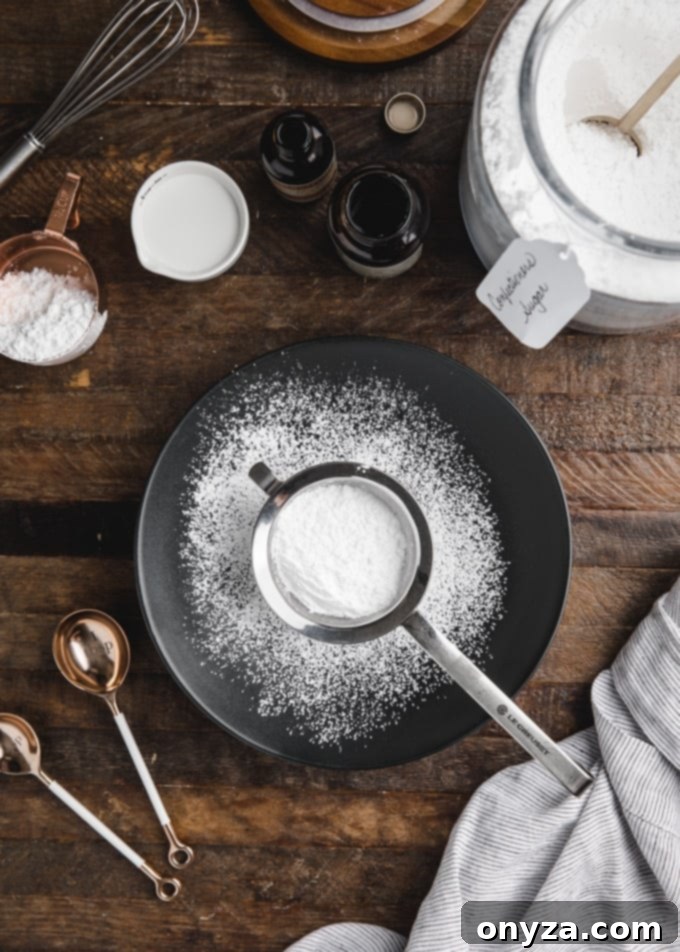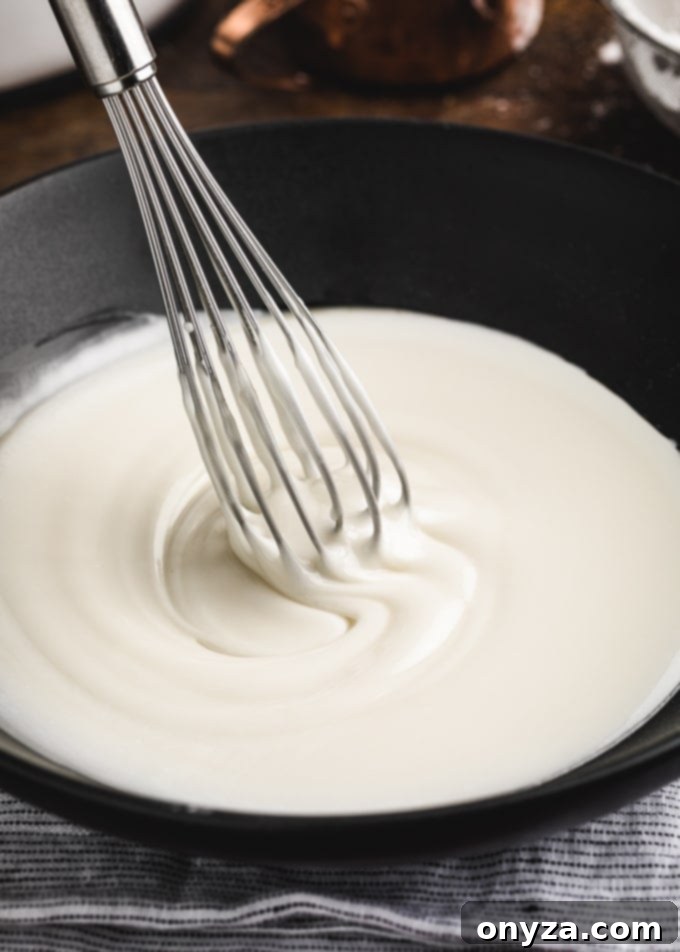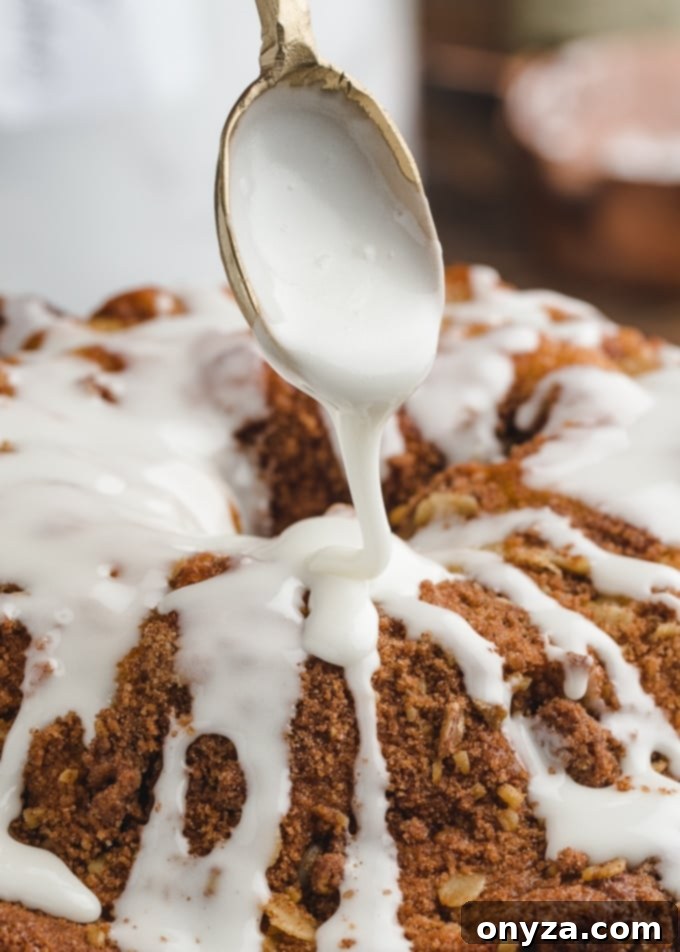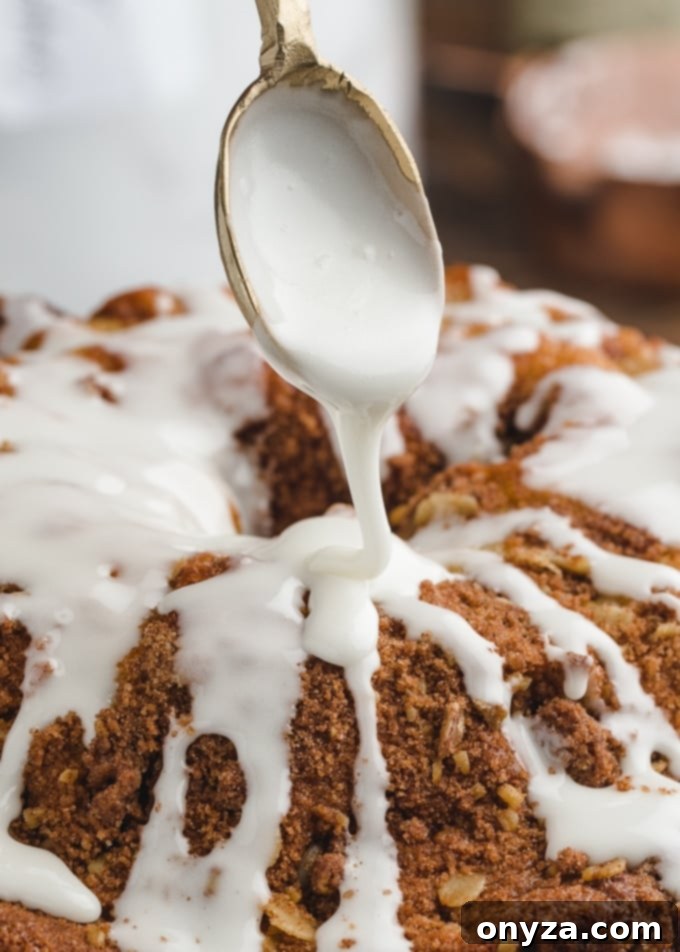Discover the secret to elevating your baked goods with an effortlessly simple yet incredibly versatile Powdered Sugar Glaze. This essential recipe, requiring just three basic ingredients and minimal time, transforms any treat into a masterpiece with a luscious, sweet drizzle. Perfect for both novice and experienced bakers, this customizable glaze is a fundamental addition to any culinary repertoire, offering endless possibilities for flavor innovation.

There’s an undeniable magic in the delicate cascade of glaze over freshly baked delights. The sight of glistening pools gently dripping down the sides of a cake and onto a serving platter instantly evokes feelings of warmth, comfort, and homemade goodness. This visual appeal, combined with the delightful taste, makes a powdered sugar glaze an indispensable finishing touch for countless desserts.
This particular recipe stands out in any baker’s collection due to its remarkable ease of preparation and its virtually limitless adaptability. It’s a foundational skill that you’ll find yourself returning to time and again, whether your dessert requires a subtle hint of sweetness, a vibrant burst of flavor, or simply that professional, polished look. Beyond its simplicity, the ability to customize this glaze means every creation can be uniquely yours, reflecting your personal taste and complementing the baked good it adorns.

The Essential Ingredients for a Perfect Powdered Sugar Glaze
The beauty of this basic glaze recipe lies in its minimalist approach. You truly only need a handful of pantry staples to create a stunning and delicious topping. For the foundational recipe, you’ll require just three core ingredients:
- Powdered Sugar: Also known as confectioner’s sugar or icing sugar, this finely ground sugar is the backbone of our glaze. Its delicate texture is crucial for achieving a smooth, lump-free consistency that sets beautifully.
- Liquid of Your Choosing: This ingredient dictates the glaze’s consistency and can significantly influence its flavor profile. Common options include water, milk (dairy or non-dairy), cream, or various liqueurs. The choice of liquid opens the door to countless flavor variations, which we’ll explore further.
- Vanilla Extract: A classic for a reason, vanilla extract adds a warm, aromatic depth that complements almost any baked good. It transforms the simple sweetness into a comforting and familiar flavor.
That’s all it takes! With these three components, you’re just minutes away from a perfectly pourable, deliciously sweet glaze.
Crafting Your Powdered Sugar Glaze: A Simple Step-by-Step Guide

Making a powdered sugar glaze is incredibly straightforward, a process that can be mastered in four easy steps. Follow along to achieve that perfect, professional finish every time:
- Sift the Powdered Sugar: Begin by sifting your powdered sugar. This crucial first step removes any lumps that may have formed in the sugar, ensuring your glaze will be silky smooth and free of gritty bits. Measure out 2 cups of sifted sugar. For accuracy, especially with finely textured ingredients like powdered sugar and flour, employ the “spoon and level” method: gently spoon the sugar into your measuring cup until it overflows, then level it off with a straight edge. This technique prevents over-packing the sugar, which can lead to an overly thick glaze.
- Combine with Liquid Gradually: Transfer the sifted powdered sugar to a medium-sized mixing bowl. Now, begin adding your chosen liquid, one tablespoon at a time. For the examples shown in the photos, a rich half-and-half was used, offering a slightly creamier texture. Starting with a smaller amount of liquid gives you greater control over the final consistency.
- Whisk to Desired Consistency: Gradually whisk the liquid into the sugar. Continue adding liquid, a tablespoon at a time, until a smooth, pourable icing forms. The ideal consistency will depend on your application: for a thin drizzle, you’ll want a slightly runnier glaze, while for a thicker coating or spread, a denser consistency is preferable. Aim for a texture that flows easily but isn’t watery.
- Introduce Vanilla (or alternative flavorings): For a classic vanilla glaze, whisk in ½ to 1 teaspoon of vanilla extract at this stage. Keep in mind that natural vanilla extract will impart a very slight ivory tint to your glaze. If you require a pure white glaze for aesthetic reasons, clear vanilla flavoring can be an excellent substitute without compromising on flavor.

Endless Possibilities: Ways to Flavor Your Powdered Sugar Glaze
One of the most exciting aspects of powdered sugar glaze is its incredible adaptability. While classic vanilla is always a winner, this basic recipe serves as a perfect canvas for a myriad of flavor enhancements. The possibilities are truly boundless, allowing you to tailor your glaze to perfectly complement any baked good. Here are some of our favorite ways to transform the basic vanilla recipe:
- Bright Citrus Glaze: For a refreshing twist, omit the vanilla extract and replace some or all of the liquid with fresh lemon, lime, or orange juice. For an even more intense citrus punch, add finely grated zest from your chosen fruit. High-quality pure citrus extracts, like those from Nielsen Massey or Rodelle, are also excellent options. This pairs wonderfully with pound cakes, muffins, or even plain sugar cookies.
- Rich Coffee Glaze: Elevate your desserts with a sophisticated coffee glaze. Use cooled, strongly-brewed coffee or espresso as all or part of your liquid. This dark, aromatic glaze is phenomenal on chocolate cakes, coffee cakes, and even plain vanilla cupcakes, adding a delightful depth of flavor.
- Warm Spiced Glaze: Infuse your glaze with cozy, aromatic spices. Ground cinnamon, nutmeg, ginger, or cardamom can be whisked directly into the powdered sugar for a warming touch. A spiced glaze is particularly inviting on apple desserts, pumpkin bread, or anything that calls for a touch of autumn comfort.
- Apple Juice or Cider Glaze: A natural choice for fall-themed baked goods, using apple juice or cider as the liquid creates a subtly fruity glaze. For an extra layer of flavor, add a pinch of ground cinnamon or nutmeg to create a spiced cider glaze, perfect for apple fritters or autumn-spiced muffins.
- Decadent Maple Glaze: Swap your liquid for pure maple syrup (avoid artificial pancake syrup for the best flavor) to create a rich and distinct maple glaze. For an even more pronounced maple aroma and taste, a few drops of maple extract can be added. This glaze is exceptional on pumpkin pancakes, sweet potato quick bread, or pecan rolls.
- Nutty or Minty Extracts: Replace the vanilla extract with pure almond, coconut, or peppermint extract to introduce exciting new flavor dimensions. An almond glaze is fantastic on fruit tarts or cherry desserts, coconut glaze brings a tropical touch to pineapple cakes, and peppermint glaze is a festive choice for chocolate brownies or holiday cookies.
- Elegant Vanilla Bean Glaze: For an elevated vanilla experience, opt for vanilla paste or the scraped seeds from a vanilla bean instead of extract. This provides a more intense, complex vanilla flavor and beautiful flecks of vanilla bean throughout the glaze, signaling a touch of gourmet craftsmanship.
- “Spiked” Adult Glaze: For a grown-up twist, substitute some of the liquid with your favorite liquor or liqueur. Bourbon adds a smoky depth, rum brings a Caribbean warmth, Grand Marnier or Chambord infuse fruitiness, Kahlúa offers coffee notes, and Limoncello provides a zesty Italian flair. These boozy glazes are excellent for special occasion cakes or adult-only treats.

Glaze Consistency Tips for a Perfect Finish
Achieving the right consistency is paramount for a successful glaze, whether you’re aiming for a delicate drizzle, a generous pour, or a spreadable coating. The key lies in the careful addition of liquid.
- For a Thin Drizzle: Start with the minimum liquid required and add drops by drops until the glaze slowly runs off a spoon in thin streams. This is ideal for adding delicate lines to cookies or a light finish to muffins.
- For a Pourable Glaze: This is a slightly thicker consistency than a drizzle. The glaze should flow smoothly and steadily from a spoon, coating the back of it without being too transparent. This is perfect for coating bundt cakes or letting it cascade down the sides of a coffee cake.
- For a Thicker, Spreadable Glaze: If you want a more opaque coating or something that can be spread with an offset spatula, use less liquid. The glaze should be thick enough to hold its shape somewhat but still spreadable. If your glaze becomes too thick, simply add more liquid, a few drops at a time, until you reach the desired texture. If it becomes too thin, whisk in a tablespoon of additional sifted powdered sugar until it thickens.
Glazing FAQ’s: Common Questions Answered
Even for a simple recipe, questions can arise. Here are answers to some frequently asked questions about making and storing powdered sugar glaze:
Q. Does powdered sugar glaze harden?
A. Yes, it does! With the appropriate ratio of powdered sugar to liquid, this glaze will dry and set to a flat, firm finish at room temperature. This allows for clean slicing of your baked goods without smudging the glaze. For optimal setting, it’s crucial to ensure that your baked goods are completely cooled before applying the glaze. Applying glaze to warm items can cause it to melt or slide off.
Q. Can I make it ahead?
A. Absolutely. This powdered sugar glaze can be prepared up to 5 days in advance of when you plan to use it. Store the glaze in an airtight container in the refrigerator to maintain its freshness. When you’re ready to use it, allow the glaze to come back to room temperature on your countertop. Give it a good whisk, and if it appears too thick after refrigeration, simply add a few drops of additional liquid (water, milk, or desired flavoring liquid) until it reaches your preferred consistency.
Q. How should I store baked goods with this glaze?
A. Baked goods coated with this basic powdered sugar glaze (even those containing milk or cream in the glaze) can generally be covered and stored at room temperature for up to 3 days. The high sugar content in the glaze acts as a natural preservative, stabilizing it against spoilage. However, if your room temperature consistently exceeds 71-72 degrees Fahrenheit, if the baked goods themselves contain a perishable filling (like cream cheese or fresh fruit), or if you simply prefer to err on the side of caution, it’s best to cover and store them in the refrigerator. For the best flavor and texture, always allow refrigerated confections to stand at room temperature for 20-30 minutes before serving.

Versatile Applications: Ways to Use a Basic Confectioner’s Sugar Glaze
This quick and easy icing is remarkably versatile, enhancing a wide array of baked goods. It’s not just for homemade treats; it can also wonderfully elevate store-bought items, giving them a personal, cozy, and homemade touch. Sometimes, a plain coffee cake or pastry from the grocery store, like the one pictured here, just needs a little something extra to make it feel special for guests or a weekend brunch. A simple glaze is an effortless way to customize and impress.
This glaze is particularly well-suited to:
- Bundt and Tube Cakes: A poured glaze beautifully highlights the intricate designs of these cakes. Imagine it cascading over a Pumpkin Bundt Cake or a delicate Pear Cake.
- Coffee Cakes: The perfect companion for any coffee cake, especially delicious with a maple-flavored glaze to deepen those comforting notes.
- Quick Breads: Transform simple quick breads like Zucchini, Carrot, Banana Bread, or Pumpkin Bread into something truly special with a sweet topping.
- Pound Cakes: A classic pairing! A Pound Cake is incredibly enhanced by a vibrant citrus glaze, adding a tangy counterpoint to its rich, buttery crumb.
- Muffins: A simple drizzle makes muffins feel more indulgent. Try a tangy lemon glaze to brighten up classic Blueberry Muffins.
- Scones: A light glaze adds just the right amount of sweetness and moisture to freshly baked scones.
- Doughnuts: Whether homemade or store-bought, a powdered sugar glaze is the quintessential doughnut topping, providing that iconic shiny finish and sweet bite.
- Cookies: This glaze can be drizzled for a decorative touch, used for dipping cookies for a full coating, or even spread for a thicker, softer layer of icing.
We’d love to hear your creative ideas! What’s your favorite way to use and flavor Powdered Sugar Glaze? Share your insights and tips in the comments below!
Powdered Sugar Glaze Recipe
This basic, customizable confectioner’s sugar glaze is an essential for any baker’s recipe collection, perfect for finishing off a wide range of desserts with ease and elegance.
Author: Amanda Biddle
Prep Time: 10 minutes
Total Time: 10 minutes
Servings: 8 to 12 servings
Ingredients
- 2 cups sifted confectioner’s sugar
- 2-4 tablespoons milk, half and half, water, or flavored liquid of choice
- ½ to 1 teaspoon vanilla extract
Instructions
- In a bowl, whisk together sifted powdered sugar, vanilla extract, and enough liquid to thin the glaze to your desired consistency for dipping, drizzling, or pouring over your favorite baked goods and pastries. The glaze should be smooth and lump-free.
- Refer to the FAQ section above for make-ahead and storage instructions, and the notes below for popular flavor variations.
Notes
Flavor Variations:
- Citrus: Omit the vanilla extract. Use fresh lemon, lime, or orange juice for some or all of the liquid. Add 1/2 to 1 teaspoon of finely-grated citrus zest for enhanced flavor. Pure citrus extracts can also be used; start with 1/4 teaspoon and adjust to taste.
- Coffee: Substitute cooled, strongly-brewed coffee or espresso for all or some of the liquid for a rich, aromatic glaze.
- Spices: Whisk in 1/4 to 1/2 teaspoon of ground cinnamon, nutmeg, cardamom, or ginger, adjusting the amount to your taste preference.
- Apple Juice or Cider: Use apple juice or apple cider as a 1:1 substitute for the liquid for a subtly fruity glaze, especially good for fall bakes.
- Maple: Use pure maple syrup (not pancake syrup) as the liquid. For a stronger maple flavor, add maple extract, starting with 1/4 teaspoon and tasting as you go.
- Extracts: Substitute vanilla with pure almond, coconut, or peppermint extract. Note that extract strengths vary, so begin with 1/4 teaspoon and add more to taste.
- Vanilla Bean: For a more gourmet touch and visible vanilla specks, incorporate vanilla paste or scraped vanilla bean seeds in place of vanilla extract.
- Spiked: Replace 1/2 to 2 tablespoons (to taste) of the liquid with your favorite liquor or liqueur, such as Bourbon, Rum, Grand Marnier, Chambord, Kahlúa, Frangelico, Irish Cream, or Limoncello.
Nutrition Estimate
Calories: 120kcal | Carbohydrates: 30g | Protein: 1g | Fat: 1g | Saturated Fat: 1g | Cholesterol: 1mg | Sodium: 2mg | Potassium: 5mg | Sugar: 30g | Calcium: 4mg
Nutrition information is automatically calculated and should only be used as an approximation.
About Our Recipes
Please note that our recipes have been developed using the US Customary measurement system and have not been tested for high altitude/elevation cooking and baking.
Other Easy Glaze Recipes to Explore:
- Cream Cheese Glaze
- Brown Butter Glaze
CRAVING MORE? Subscribe to our newsletter and connect with us on Facebook, Pinterest, and Instagram for the latest recipes and culinary inspiration.
